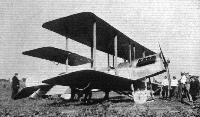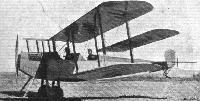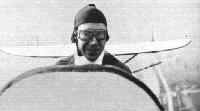P.Bowers Curtiss Aircraft 1907-1947 (Putnam)
Model R Series (Model 2)
Following Curtiss's acquisition of designers experienced with tractor-type aeroplanes, the company sought to develop larger and more advanced models than the J and N for military use. The first such effort was the two-seat Model R, a tandem two-seater introduced early in 1915 and powered with the new 160 hp Curtiss V-X engine that was essentially an enlargement of the well established O and OX models. The Model R was not notably successful but, thanks to having no significant competition, enjoyed brisk sales to both the US Army and Navy from 1915 until the end of the war and remained in Navy service into 1926. Early models were also bought by Britain's Royal Flying Corps.
R - The prototype R could be regarded as an enlarged version of the original Model N, with equal-span wings, RAF 6 aerofoil, no dihedral, and shoulder-type aileron control. The most noticeable differences, other than the size, were the extremely heavy stagger of the wings and the use of a single long cockpit for both occupants. Although heavier than the N, the R was still light enough for its balance to be affected by crew location, so the pilot occupied the rear seat. The presence or absence of the observer in the front cockpit, located on the centre of gravity, did not affect the balance of the aeroplane. The single company-owned prototype was soon modified by the addition of dihedral and tested both as a land plane and as a single-float seaplane.
R-2A - The R-2A was a parallel development with the R-2 but was completed first. Again, the crew was in two separate cockpits and the tail and landing gear were redesigned, but the wings were equal-span and retained the interplane ailerons and no-dihedral rigging. In August 1915, Curtiss pilot Raymond V. Morris overloaded the R-2A and set an American altitude record of 8,105 ft (2,470 m) for pilot and three passengers.
Журнал Flight
Flight, December 11, 1914.
AEROPLANE TYPES,
THE CURTISS TRACTOR BIPLANES.
<...>
The latest Curtiss tractor (Fig. 3), built for the abandoned U.S. Military Trials, shown in one of the accompanying illustrations which we reproduce from our American contemporary Flying, differs from the model J tractors in the main planes and chassis. The former, which have a Morane-Saulnier plan form - larger span at the trailing edge - are set at a pronounced dihedral angle, and top and bottom planes are of equal span. The ailerons, of which there are two, are of substantial size, and are mounted between the top and bottom planes on the two outer rear struts.
The chassis consists of two skids, upturned at their forward ends, which project beyond the tractor screw, connected to the fuselage by three struts each. Two of the latter are connected to the skids close together, one on either side of an axle carrying a pair of running wheels and sprung to the skids. In other respects this machine is very much the same as those previously mentioned.
Flight, May 7, 1915.
THREE NEW AMERICAN MACHINES.
FOR some time past there has been noticeable a certain activity among American aeroplane manufacturers, consequent no doubt upon the increased interest being taken by the U.S. Government in military aviation, which it is hoped will lead to the handing out of substantial orders very shortly. It is also not unlikely that some of the firms hope to do considerable business with European Governments, and it is interesting to notice how the general design of some of the latest machines approximates very closely to those which have proved most successful over here. This is clearly shown in the photographs which we reproduce of some military tractors that have recently made their first appearance, and passed their preliminary trials.
Although retaining a sufficient number of Curtiss characteristics to make her instantly recognisable as coming from the hand of this designer, the new Curtiss military tractor shows pronounced departures from its prototypes. In the latest machine, which has a Curtiss engine of 160 h.p., the main planes are set at a considerable forward stagger, whilst being straight as seen from in front, that is to say, having no dihedral angle. Ailerons are as usual hinged to the outer rear inter-plane struts instead of to the trailing edge of the upper plane, as is the general practice on this side of the "pond." Pilot and passenger are accommodated tandem fashion in the same cock-pit, and appear to be placed unusually far back, even allowing for the extra weight of the 160 h.p. engine. The chassis is, on the other hand, placed very far forward, supporting, in fact, the engine only, leaving the combined weight of pilot, passenger, controls and instruments unsupported, an arrangement which would seem to impose severe bending stresses in the body in a heavy landing.
<...>
Flight, August 27, 1915.
EDDIES.
With the alertness for sensing the ever-occurring changes in requirements, that is so characteristically American, and with their up-to-date methods of manufacture, that are typical of the Curtiss Aeroplane Company, and which enable them to meet these requirements, this firm have lately produced a machine which will be known as Model R, designed with a view to combine good speed and climb with weight-carrying capacity. This Curtiss military tractor is in its present form built as a three seater, the observers being placed approximately over the e.g., while the pilot sits well back in a separate cockpit slightly to the rear of the planes. The engine - a 160 h p. Curtiss - drives a three-bladed propeller, which, as in other types of Curtiss machines, is of comparatively small diameter, allowing a very low chassis to be employed. Judging from reports of the preliminary flights that took place at the firm's flying ground at Buffalo, N.Y., the new machine promises exceedingly well. In the first trip the pilot, Raymond V. Morris, accompanied by two passengers, Lieut. McIlvain of the Marine Corps and C. W. Webster of the Curtiss Aeroplane Co., climbed to a height of 8,200 feet in 27 minutes, which besides constituting an American altitude record, sounds pretty satisfactory.
***
Later in the day Morris was up again, this time accompanied by three passengers, and established another American record by reaching a height of 8,300 ft. Had it not been for the fact that the barograph took it into its head to cease barographing at this point, a considerably greater height would have been achieved. Experts who witnessed the flight, the official observer, who was one of the passengers, and the pilot all agreed, I understand, that the machine would have been good for another 4,000 ft. at least. When a new barograph, registering up to 25,000 ft., is ready, Morris and a passenger are to have a try at beating one or two world's records, not only the one of 6,170 metres, established by Lieut. Bier at Aspern in June, 1914, but also Oelerich's record of 8,150 metres for pilot alone, which he made at Lindenthal, Leipzig, in July, 1914. And, knowing how well the smaller Curtiss machines have climbed over here with Sydney Pickles at the helm, I shall not be in the least surprised either to see Morris getting ahead of the German record.
"AEOLUS."









